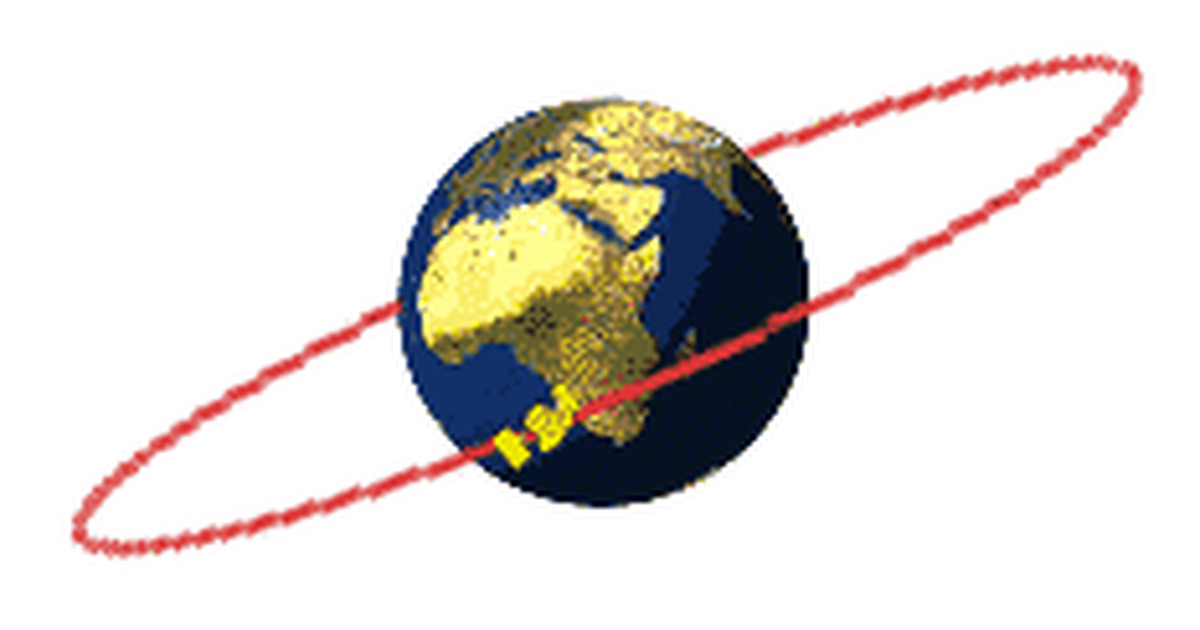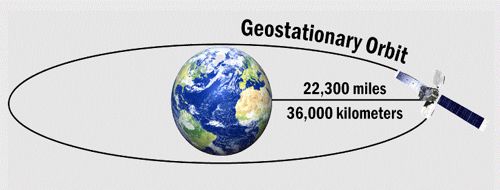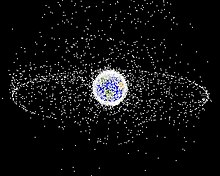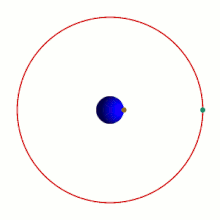Earth-centered orbit with an orbital period that matches Earth's rotation on its axis, 23 hours, 56 minutes, and 4 seconds (one sidereal day).Wikipedia



For a geosynchronous orbit, the orbit has to take 24 hours instead of 90 minutes, because the earth takes 24 hours to spin. This happens when the circle is expanded to an altitude of about 35000 km. The Goldilocks velocity at this altitude is about 3000 m/s. This is all somewhat simplified, but the broad strokes are all there. As well as allowing continuous communication with ground stations, a geosynchronous orbit also allows a larger portion of the sky to be viewed continuously. Difference between Geosynchronous and Geostationary Orbit. The curved path in space is called an orbit while an orbital period of one sidereal day is known as a geosynchronous orbit. On the other hand, an orbit lying in the plane of the earth’s equator is known as. A geosynchronous orbit is any orbit which has a period equal to the earth's rotational period. As we shall soon see, this requirement is not sufficient to ensure a fixed position relative to the earth. While all geostationary orbits must be geosynchronous, not all geosynchronous orbits are geostationary.
- Geostationary orbit
Circular geosynchronous orbit 35786 km above Earth's equator and following the direction of Earth's rotation. Orbit has an orbital period equal to the Earth's rotational period, one sidereal day, and so to ground observers it appears motionless, in a fixed position in the sky.Wikipedia
- Tundra orbit
Highly elliptical geosynchronous orbit with a high inclination (approximately 63.4°), an orbital period of one sidereal day, and a typical eccentricity between 0.2 and 0.3. A satellite placed in this orbit spends most of its time over a chosen area of the Earth, a phenomenon known as apogee dwell, which makes them particularly well suited for communications satellites serving high latitude regions.Wikipedia
- Geocentric orbit
A geocentric orbit or Earth orbit involves any object orbiting the Earth, such as the Moon or artificial satellites. In 1997 NASA estimated there were approximately 2,465 artificial satellite payloads orbiting the Earth and 6,216 pieces of space debris as tracked by the Goddard Space Flight Center.Wikipedia
- Geosynchronous satellite
Satellite in geosynchronous orbit, with an orbital period the same as the Earth's rotation period. Typically some form of analemma.Wikipedia
- Low Earth orbit
Earth-centred orbit with an altitude of 2000 km or less (approximately one-third of the radius of Earth), or with at least 11.25 periods per day ( an orbital period of 128 minutes or less) and an eccentricity less than 0.25. Most of the artificial objects in outer space are in LEO.Wikipedia
- Supersynchronous orbit
Either an orbit with a period greater than that of a synchronous orbit, or just an orbit whose apoapsis is higher than that of a synchronous orbit. A synchronous orbit has a period equal to the rotational period of the body which contains the barycenter of the orbit.Wikipedia
- Satellite
Object that has been intentionally placed into orbit. These objects are called artificial satellites to distinguish them from natural satellites such as Earth's Moon.Wikipedia
- High Earth orbit
Geocentric orbit with an altitude entirely above that of a geosynchronous orbit . Expansion - crusader kings ii: the republic download free. Apparent retrograde motion – that is, even if they are in a prograde orbit , their orbital velocity is lower than Earth's rotational speed, causing their ground track to move westward on Earth's surface.Wikipedia
- Polar orbit
One in which a satellite passes above or nearly above both poles of the body being orbited on each revolution. Inclination of about 60 - 90 degrees to the body's equator.Wikipedia
- Semi-synchronous orbit
Orbit with a period equal to half the average rotational period of the body being orbited, and in the same direction as that body's rotation. Considered a medium Earth orbit, with a period of just under 12 hours.Wikipedia
- Molniya orbit
Type of satellite orbit designed to provide communications and remote sensing coverage over high latitudes. Highly elliptical orbit with an inclination of 63.4 degrees, an argument of perigee of 270 degrees, and an orbital period of approximately half a sidereal day.Wikipedia
- 3753 Cruithne
Q-type, Aten asteroid in orbit around the Sun in 1:1 orbital resonance with Earth, making it a co-orbital object. Asteroid that, relative to Earth, orbits the Sun in a bean-shaped orbit that effectively describes a horseshoe, and that can change into a quasi-satellite orbit.Wikipedia
- Highly elliptical orbit
Elliptic orbit with high eccentricity, usually referring to one around Earth. Examples of inclined HEO orbits include Molniya orbits, named after the Molniya Soviet communication satellites which used them, and Tundra orbits.Wikipedia
- Areosynchronous orbit
The areosynchronous orbits (ASO) are the synchronous orbits for artificial satellites around the planet Mars. They are the martian equivalent of the geosynchronous orbits (GSO) on the Earth.Wikipedia
- List of satellites in geosynchronous orbit
List of satellites in geosynchronous orbit . These satellites are commonly used for communication purposes, such as radio and television networks, back-haul, and direct broadcast.Wikipedia
- Earth observation satellite
Satellite used or designed for Earth observation from orbit, including spy satellites and similar ones intended for non-military uses such as environmental monitoring, meteorology, cartography and others. The most common type are Earth imaging satellites, that take satellite images, analogous to aerial photographs; some EO satellites may perform remote sensing without forming pictures, such as in GNSS radio occultation.Wikipedia
- Gliese 876 c
Exoplanet orbiting the red dwarf Gliese 876, taking about 30 days to complete an orbit. Discovered in April 2001 and is the second planet in order of increasing distance from its star.Wikipedia
- Equinox
Commonly regarded as the instant of time when the plane of Earth's equator passes through the geometric center of the Sun's disk. This occurs twice each year, around 20 March and 23 September.Wikipedia
- 2020 SW
Tiny near-Earth asteroid discovered by the Mount Lemmon Survey on 18 September 2020, six days before it made its closest approach to Earth. Apollo-type orbit to an Aten-type orbit with a semi-major axis within one astronomical unit from the Sun.Wikipedia
- Orbital period
Time a given astronomical object takes to complete one orbit around another object, and applies in astronomy usually to planets or asteroids orbiting the Sun, moons orbiting planets, exoplanets orbiting other stars, or binary stars. Often referred to as the sidereal period, determined by a 360° revolution of one celestial body around another, e.g. the Earth orbiting the Sun.Wikipedia
- 67P/Churyumov–Gerasimenko
Jupiter-family comet, originally from the Kuiper belt, with a current orbital period of 6.45 years, a rotation period of approximately 12.4 hours and a maximum velocity of 135000 km/h. Approximately 4.3 by at its longest and widest dimensions.Wikipedia
- 2010 TK7
Sub-kilometer near-Earth asteroid and the first Earth trojan discovered to date; it precedes Earth in its orbit around the Sun. Trojan objects are most easily conceived as orbiting at a Lagrangian point, a dynamically stable location (where the combined gravitational force acts through the Sun's and Earth's barycenter) 60 degrees ahead of or behind a massive orbiting body, in a type of 1:1 orbital resonance.Wikipedia
- MEASAT-3b
Communications satellite which MEASAT and Trans Media operates in geosynchronous orbit at 91.5 degrees east longitude, co-located with MEASAT-3 and MEASAT-3a, with orbital period of 1436.1 minutes and orbital speed of ~3.08 km/s . Built by Astrium , based on the Eurostar spacecraft platform, with an investment of approximately MYR1.25bn ($370m), and the 5th MEASAT satellite in orbit.Wikipedia
- Near-equatorial orbit
Orbit that lies close to the equatorial plane of the object orbited. Orbit has an inclination near 0°.Wikipedia
- Vinasat-2
Second Vietnamese satellite to be placed in orbit. Launched at 22:13 UTC on May 15, 2012 at the European Spaceport in Kourou in French Guiana in South America and entered orbit 35 minutes later.Wikipedia
- Geostationary transfer orbit
Type of geocentric orbit. Intermediate step for reaching their final orbit.Wikipedia
- (391211) 2006 HZ51
Bright, sub-kilometer asteroid on an eccentric orbit, classified as a near-Earth object and a potentially hazardous asteroid of the Amor group. Discovered on 27 April 2006, by astronomers of the Catalina Sky Survey conducted at Mount Lemmon Observatory, Arizona, United States.Wikipedia
- (10115) 1992 SK
Stony near-Earth object and potentially hazardous asteroid on an eccentric orbit. It belongs to the group of Apollo asteroids and measures approximately 1 km in diameter.Wikipedia
Sentences forGeosynchronous orbit

Geosynchronous Orbit
- As television became the main market, its demand for simultaneous delivery of relatively few signals of large bandwidth to many receivers being a more precise match for the capabilities of geosynchronous comsats.Communications satellite-Wikipedia
- 3 of the satellites are placed in the Geostationary orbit (GEO) and the remaining 4 in the Geosynchronous orbit (GSO) to have a larger signal footprint and lower number of satellites to map the region.Satellite navigation-Wikipedia
- The Geosynchronous orbit (GEO) communications satellites provide commercial satellite services such as direct-to-home digital television, business data transmission, cable program distribution and wireless communications.Orbital Sciences Corporation-Wikipedia
- Geosynchronous orbit launches historically taking advantage of economies of scales with larger launch vehicles and greater use of the maximum payload capacity of a vehicle vs LEO launches.Space launch market competition-Wikipedia
- For example, a geostationary satellite completes one orbit per day above the equator, or 360 degrees per 24 hours, and has angular velocity ω = (360°)/(24 h) = 15°/h, or (2π rad)/(24 h) ≈ 0.26 rad/h.Angular velocity-Wikipedia
- Western Union became the first American telecommunicationscorporation to maintain its own fleet of geosynchronous communications satellites, starting in 1974.Western Union-Wikipedia
Geosynchronous Orbit Radius
- An early orbit calculation showed that it was orbiting Earth in an extremely elliptical orbit, taking it from within the geosynchronous satellite ring to nearly twice the distance of the Moon.WT1190F-Wikipedia
- The STAR-2 Bus is a fully redundant, flight-proven, spacecraft bus designed for geosynchronous missions.GEOStar-2-Wikipedia
- Iran is also planning to launch satellites into orbits of up to 36,000 km.Iranian Space Agency-Wikipedia
- Moonshine was to be a joint effort with NASA to determine the feasibility of a geosynchronous satellite that could in project light directly down on any desired location.Operation Shed Light-Wikipedia
- The first standardized satellite bus design was the HS-333 geosynchronous (GEO) communication satellite launched in 1972.Satellite-Wikipedia
- propellant residuals, it successfully put the bird on a 250 km orbit above GSO and Nahuel 1A was switched off.Nahuel 1A-Wikipedia
- Specifically, geosynchronous Earth orbit (GEO) may be a synonym for geosynchronous equatorial orbit, or geostationary Earth orbit.List of satellites in geosynchronous orbit-Wikipedia
- In the most recent report, Roman was considered for both geosynchronous and L2 orbits.Nancy Grace Roman Space Telescope-Wikipedia
- It is capable of the assembly, integration and testing of several satellites of type Low Earth orbit (LEO) and Geosynchronous orbit (GEO) with a mass up to five tonnes simultaneously.Turkish Space Systems, Integration and Test Center-Wikipedia
- The primary application for this thruster design is intended for satellite station-keeping, long term LEO to GEO orbit transfers and deep space applications.Helicon double-layer thruster-Wikipedia
- For example, the levels of ionizing radiation and radio interference can vary by factors of hundreds to thousands; and the shape and location of the magnetopause and bow shock wave upstream of it can change by several Earth radii, exposing geosynchronous satellites to the direct solar wind.Solar wind-Wikipedia
- It will be the first ISRO made satellite to move from Geostationary transfer orbit to Geosynchronous orbit using Electric Propulsion.GSAT-20-Wikipedia
- If the orbit is a geosynchronous one, then c=1 and the trace is a Viviani's curve.Clélie-Wikipedia
- A space elevator is a theoretical system using a super-strong ribbon going from the surface of the Earth to a point beyond Geosynchronous orbit.Space elevator competitions-Wikipedia
- But science fiction writers have a fairly good track record in predicting future technologies—for example geosynchronous communications satellites (Arthur C. Clarke) and many aspects of computer technology (Mack Reynolds).Interplanetary spaceflight-Wikipedia
- The Geosynchronous-belt subsynchronous orbital regime is regularly used in spaceflight.Subsynchronous orbit-Wikipedia
- In the orbits nearest to Earth—less than 2000 km orbital altitude, referred to as low-Earth orbit (LEO)— there have traditionally been few 'universal orbits' which keep a number of spacecraft in particular rings (in contrast to GEO, a single orbit that is widely used by over 500 satellites).Space debris-Wikipedia
- In June 2014, the company was contracted by the United States Air Force on a fixed-price basis to build the fifth and sixth Geosynchronous Earth Orbit (GEO) satellites, known as GEO-5 and GEO-6, for the Space-Based Infrared System (SBIRS) at a cost of US$1.86 billion.Lockheed Martin Space-Wikipedia
- ! ..to GTO or GSOHeavy-lift launch vehicle-Wikipedia
- AMSC initially provided GEO based satellite services based on its MSAT satellite.SkyTerra-Wikipedia
- One advantage of GPS is all orbits from Low Earth orbit to Geosynchronous orbit can use GPS for ACS.Astrionics-Wikipedia
- Orbits with mean altitudes higher than LEO (such as Medium Earth orbits (MEO), Geosynchronous orbit/Geostationary orbit (GSO/GEO), and other species) are far from the denser parts of the atmosphere, making full de-orbit burns significantly more impractical.Collision avoidance (spacecraft)-Wikipedia
- One particular supersynchronous orbital regime of significant economic value to Earth commerce is a band of near-circular Geocentric orbits beyond the geosynchronous belt—with perigee altitude above 36100 km, approximately 300 km above synchronous altitudeSupersynchronous orbit-Wikipedia
- Even the lower specific impulse represents a significant increase over that of conventional chemical rockets, however, an increase that can provide substantial payload gains (45 percent for a LEO-to-GEO mission) at the expense of increased trip time (14 days compared to 10 hours).Solar thermal rocket-Wikipedia

Geosynchronous Orbit Vs Geostationary
This will create an email alert. Stay up to date on result for: Geosynchronous orbit
